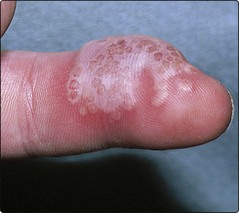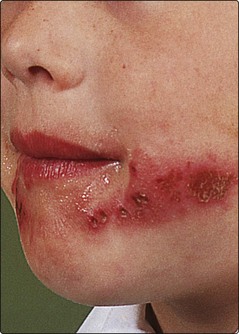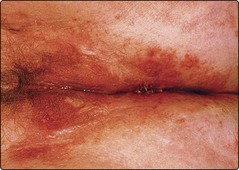Viral infections – Herpes simplex and herpes zoster
Herpes simplex
Clinical presentation
Herpetic whitlow is another presentation (Fig. 1). A painful vesicle or pustule is found on a finger in, for example, a nurse or dentist attending a patient secreting the virus. Similar direct inoculation is sometimes seen in sportsmen such as wrestlers (‘herpes gladiatorum’).
Recurrence is a hallmark of herpes simplex infection; it occurs at a similar site each time, usually on the lips, face (Fig. 2) or genitals (Fig. 3). Rarely, herpes simplex may appear in a zosteriform dermatomal distribution. The outbreak of groups of vesicles is often preceded for a few hours by tingling or burning. Crusts form within 24–48 h, and the infection fades after a week. Attacks may be precipitated by respiratory infection (hence ‘cold’ sore), sunlight or local trauma.
Complications
Complications are infrequent but can be serious. They include the following:
 Secondary bacterial infection. This is usually due to Staphylococcus aureus.
Secondary bacterial infection. This is usually due to Staphylococcus aureus.
 Eczema herpeticum. Widespread herpes simplex infection is a serious and potentially fatal complication seen in patients with atopic eczema (p. 36
Eczema herpeticum. Widespread herpes simplex infection is a serious and potentially fatal complication seen in patients with atopic eczema (p. 36
Stay updated, free articles. Join our Telegram channel

Full access? Get Clinical Tree





